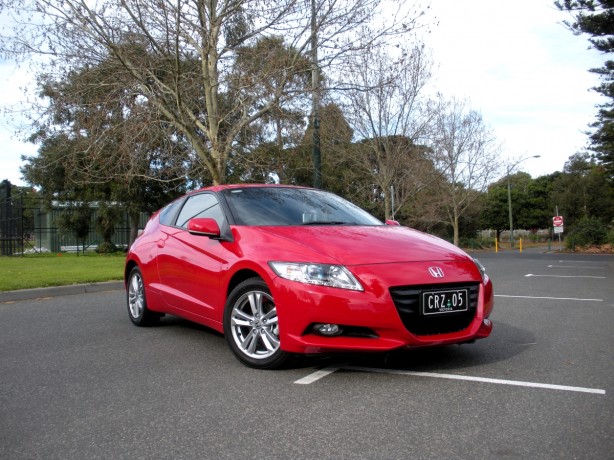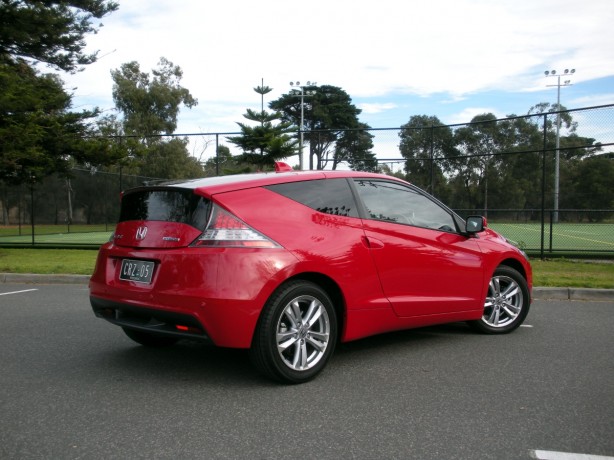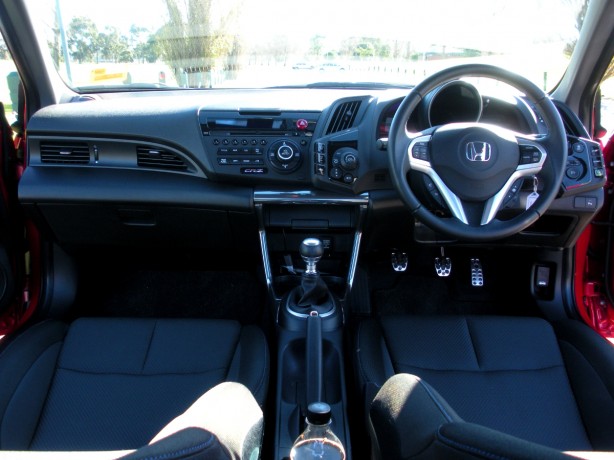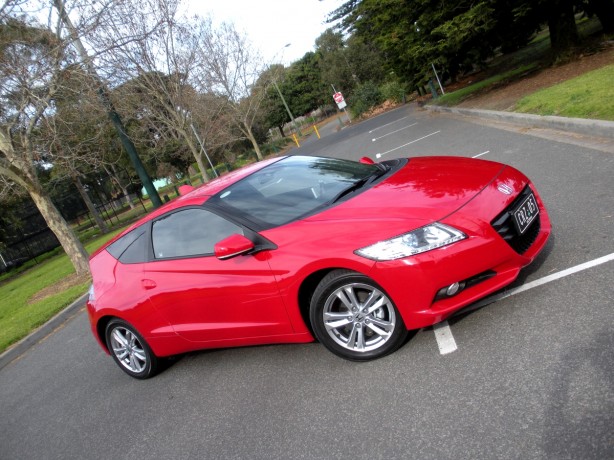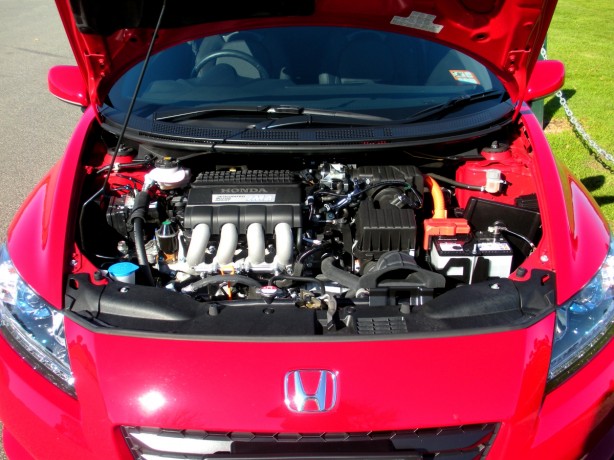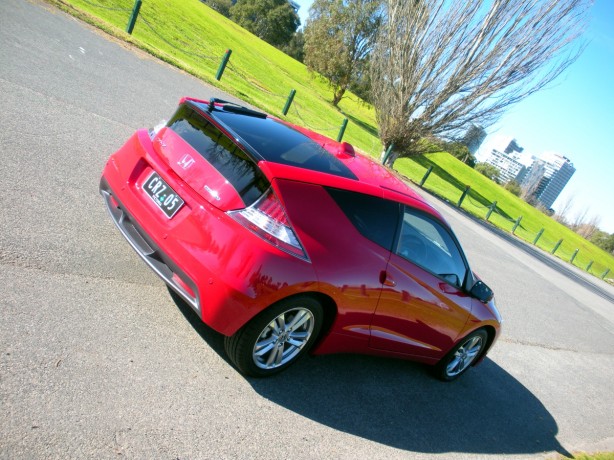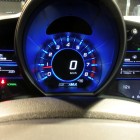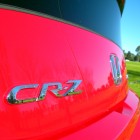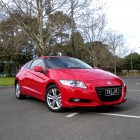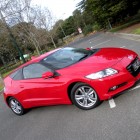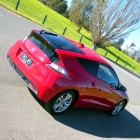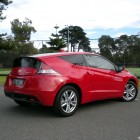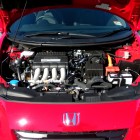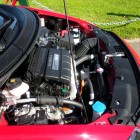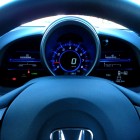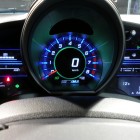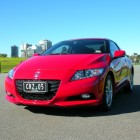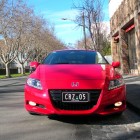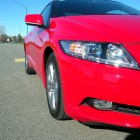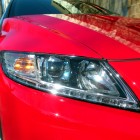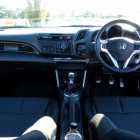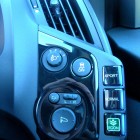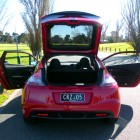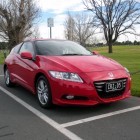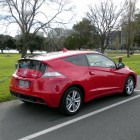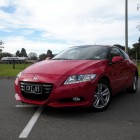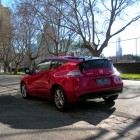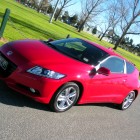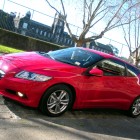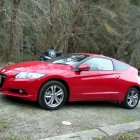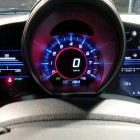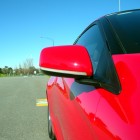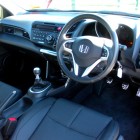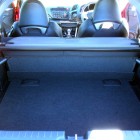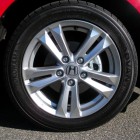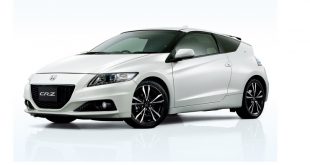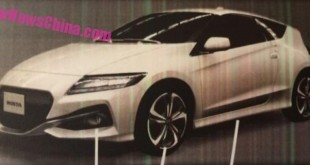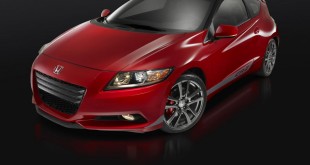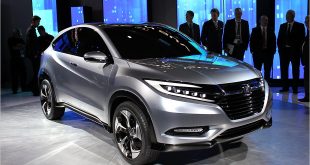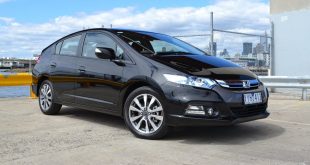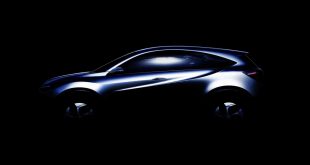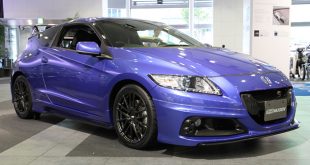Sport and Hybrid, two words that have never gone together, until the arrival of Honda’s latest environmentally friendly car, the Honda CR-Z. It’s a car designed to prove two things: Hybrid can be sporty, and Sporty can be fuel efficient. Honda calls this new category created by the CR-Z, sport hybrid.
There is no question that the CR-Z’s traits can be traced back to the small two-seat coupe from the late 1980s and early 1990s called the CRX, a car that has since become popular among Honda’s performance and tuning enthusiasts. Like the CR-Z, the CRX was designed to be sporty and economical, albeit not in a hybrid form.
The CR-Z’s power comes from a 1.5 litre four-cylinder petrol engine assisted by a battery-powered electric motor. Unlike conventional hybrids where the car can travel on electric propulsion alone, the CR-Z’s electric motor only runs when the petrol engine is running.
The concept is when more power is needed, such as ascending a slope or overtaking, the batteries discharge and the electric motor kicks in to assist the engine in providing that extra power. This means the engine does not have to work much harder to meet the power demand, resulting in better fuel efficiency. During deceleration or braking, the otherwise wasted kinetic energy are used to charge the batteries, storing energy in them ready for next use. Honda called this technology Integrated Motor Assist (IMA).
Combined, the CR-Z has a total power output of 91 kW at 6000 rpm. It is also the only hybrid currently on the market to be offered a proper six-speed manual transmission, which is what’s in our test car. A continually variable transmission (CVT) is also available.
Design & Comfort
Arriving at Honda Australia to pick up our test car was the first time I have seen the CR-Z up close. As I walked towards the Milano Red CR-Z Sport sitting at the parking lot, the car quickly raised a question in my head, is this really a Hybrid? There is no doubt the CR-Z looks nothing like the other hybrids currently on sale in the market, and that includes the CR-Z’s cousin, the Honda Insight.
Hybrids are mostly boring to look at and designed to be anonymous on the road. The CR-Z’s design however, is far from boring. It is actually a very sporty two-door coupe that demands attention rather than becomes unknown. The car sits low and wide, just like a sports car. The front has a long nose that incorporates a large front grille. The raked rear window blends well with the edgy rear lights and high rear bumper. Sharp and distinctive lines along the sides of the car further enhance the sporty wedge shape side profile. The car’s overall design is well proportioned, especially the front end, which I think is the best looking part of the car.
Getting into the CR-Z takes a little getting used to for those who are not accustomed to the low slung design of sports cars. You sit very low in the car, which further reminds you that the CR-Z is not just a hybrid but a sport hybrid.
Despite how low you are to the ground, the driving position is excellent and you get good front visibility from the wide wrap-around front windscreen and thin A pillars. However, the same can’t be said for rear visibility as your view is hindered by the massive C pillars. This is not so much of an issue when driving, as the view out the two-tier rear windscreen is not bad. It becomes an issue during parking, reversing or maneuvering the car in a tight spot, as you can virtually see nothing out of those tiny rear quarter windows. Parking sensors have never been so useful.
The CR-Z’s well shaped sports seats for the driver and passenger are comfortable and provide enough lateral and thigh support during hard cornering. If you are of a larger built though, you will find them a little snug. Being a two-door, the interior is small. There is not much gap between the driver and passenger seats, which makes carrying a passenger an intimate affair.
In the back there are seating capacity for two, at least according to the manual. But trying to fit anyone in the back is like trying to squeeze someone into a luggage case. With the front seats adjusted to suit average people, the back seats are really only good for nothing but storage, making the CR-Z realistically a two-seater.
Once you are nicely tucked in the driver’s seat, you will be greeted by the space-age dashboard, which I really like. Everything from the gauges, indicators, climate controls, entertainment system and driving modes, bar the two air-con vents for the passenger, is driver oriented. The tachometer and digital speedometer are housed in a center tunnel directly in front of the driver, viewable only from the driver’s seat, preventing any attempts for the missus in the passenger seat to check the speed you are doing (awesome).
Storage space is scarce in the CR-Z. Due to the small interior, there is no center storage compartment. The glove box is small and the space in it is mostly taken up by the user and service manual. Having said that, the CR-Z will happily transport larger items in the back with the rear seats folded down, revealing a decent 401 litres of total boot capacity.
Score: 8.5/10
Handling & Performance
Normally in a hybrid review, this section becomes irrelevant as the only thing that matters is how much it can save you at the bowser. In the CR-Z’s case of being a sport hybrid though, this section actually becomes more relevant.
At first opportunity of good weather, I took the CR-Z for a spin on some challenging mountainous roads to see if the CR-Z deserves to keep its “Sport Hybrid” nameplate or is merely just another boring hybrid. And boy was I impressed with the handling. But before diving in too deep, I should first explain the three driving modes that you can choose from in the CR-Z.
First up is the ECON mode, which as the name suggests, pitch the car towards better fuel economy. In this mode, the car feels as if it’s deprived of fuel. It seems like the engine is only allowed to zip a small quantity of fuel no matter how much you have your foot down on the pedal. Even with the electric motor kicking in, the car just feels lethargic. This makes the ECON mode only good for long distance highway cruising or heavy start/stop traffic.
Then there is the Normal mode, which gives a good balance between fuel efficiency and performance. This mode is what I would use in day to day driving. In reality, there is not much difference in terms of fuel consumption between Normal mode and ECON mode in urban driving.
To coach the driver in economical driving techniques, a so called “Ambient Meter” surrounding the digital speedometer changes colour, depending on how heavy your right foot is. Green means you are keeping the birds and trees happy, blue means you are starting to annoy the hippies but things are still okay and red means you are warming up the planet.
Finally, the Sport mode and this is what makes all the difference in the CR-Z. In Sport, the throttle response is sharpened, the steering becomes more responsive and weights up to provide more feedback from the road, and the Ambient Meter now glows solid red to signifies “screw the environment!”. The Sport button though, is not just for show, you can actually feel the difference.
With the driving mode set to Sport, the CR-Z ploughs through the winding roads with excellent stability and grip. Weighing in at just over 1,155 kg for the manual, the car feels very nimble through the corners with little understeer and bodyroll. The CR-Z’s weight is surprisingly well distributed between front and rear, thanks to the location of the batteries just behind the rear seats on the passenger side. This translates into a very well balanced chassis. In fact you can get the rear to slip a little if you garner enough speed and snap the car in a 90 degree turn in.
The 1.5 litre engine revs effortlessly to its 6,500 rpm redline. It sounds good too. You get this nice deep engine note in the lower rpm ranges that sounds like a light pressure turbocharged engine. Floor the pedal past 4,000rpm and engine screams all the way to the redline with a distinctive whine as the throttle opens up.
The close ratio six-speed manual is properly good and is a joy to work through. It has a short shifter with short travels between gears. Coupled with the light clutch pedal, shifting through the gears is fun and effortless. The manual box also has a useful feature called the Hill Start Assist (HSA) which prevents the car from rolling backward on a slope for a few seconds after the brake is released, giving the driver time to apply the throttle.
Despite being a hybrid, the CR-Z is not boring at all. It is actually a properly good, fun car to drive around the twisties. Things are a bit different in a straight line though, the car is not as fast or capable as it is around the corners. In Sport mode, the CR-Z managed a 0-100 km/h time of 8.8 seconds (tested), just not fast enough to be called a sports car. It can certainly do with a little more power, perhaps with a 1.8-litre engine instead of the 1.5.
The sports suspension soaks up road imperfections surprisingly well. Riding on 16-inch alloy wheels wrapped in Yokohama Advan tyres, the ride is smooth around town and on the freeway. When travelling on rough surfaces however, there is too much tyre and road noise intruding into the cabin.
Score: 8.5/10
Quality
Cabin fit and finish is top-notch in the CR-Z. Gaps are tight and panels solidly put together. With 4,500 km on the clock in our test car, there is no noticeable rattle in the cabin.
The soft-touch plastics used in the upper tier of the dash and doors feel expensive, so are the knobs and buttons that litter across the futuristic dash. There are however still some cheap plastics around the lower section of the center console and around the gear lever. This is not excusable if you have to pay over A$34k for the CR-Z.
The leather stitched steering wheel feels good to hold and the alloy pedals add a sporty touch to the interior.
Overall, the dark-coloured cabin is a nice place to be in but for an asking price of almost A$35k, there is a lot more to be desired.
Score: 7.5/10
Economy
Fuel efficiency is everything in a hybrid and the CR-Z is no exception. To go to lengths to save fuel, the CR-Z’s engine actually shuts itself down when you roll to a stop, with the gear in neutral and clutch disengaged. You might have to explain to your passenger at this point in time that no, you actually didn’t stall the car. As soon as you engage first gear, the engine fires up. This helps save a great deal of fuel on idle. There is a slight shudder every time the engine starts up which takes a bit of getting used to.
Honda claims the CR-Z manual will return a combined fuel consumption figure of 5.0 litres/100km.
In a week of driving covering a total distance of approximately 700 km consisting of 40% urban, 30% freeway and 30% red-blooded spirited driving with equal use of all three driving modes, I managed 6.4 litres/100 km. Remarkable in a sports car perspective but unimpressive in a hybrid point of view. However, considering the amount of fun you can have in the CR-Z around the bends, the figure suddenly seems exceptional.
Unlike most proper performance cars, the CR-Z will happily accept regular 91 RON unleaded fuel.
Score: 8.5/10
Features
The CR-Z Sport’s standard features includes climate control, automatic headlights, rain sensing wipers, daytime running lights, a six-disc CD changer with iPod connectivity and Bluetooth, trip computer, cruise control and rear parking sensors.
The 6-speaker sound system found in the CR-Z Sport is a disappointment. For the sort of money Honda is charging its customers for the CR-Z Sport, the sound system could have been better. While there is enough treble, the system struggles in the mid-range and lacks bass, an important aspect that the majority of the CR-Z buying demographic will consider.
There are a total of six airbags in the CR-Z, as well as a host of active safety features such as Vehicle Stability Assist with traction control (TCS), brake assist and electronic brake-force distribution (EBD), earning the CR-Z a five star ANCAP rating.
Score: 8/10
Verdict
Is the Honda CR-Z a proper sports coupe? Not really. Has the CR-Z managed to scrap the word “boring”, normally associated with hybrids and replace it with “Sporty”? Oh yes.
The CR-Z does not only look sporty, but is also a sporty handler. The chassis and six-speed manual gearbox is excellent. It may not have the performance of an outright sports car, but the whole point of the CR-Z is to deliver a youthful, fun and involving driving experience yet remain relatively thrifty on fuel, through which the CR-Z Sport Manual managed to pull off nicely.
| Price (Excl. On-roads): | From $34,990 – $40,964. As tested: $34,990 |
| Vehicle Warranty: | 3 years/100,000 kilometres |
| Battery Warranty: | 8 years/unlimited kilometres |
| Engine: | 1.5-litres, 4-cylinder, SOHC + Integrated Motor Assist, 91kW/174Nm |
| Transmission: | 6-speed manual (as tested)/Continually Variable Transmission |
| Body: | 2 Door Sports Coupé |
| Safety: | 5-star ANCAP |
| Dimensions: | Length: 4080mm, Width: 1740mm, Height: 1395mm,Wheelbase: 2435mm |
| Kerb Weight: | 1155kg – 1190kg |
Car reviewed is based on Australian Specified model and may differ to that available in your country of residence
 ForceGT.com Car News, Car Reviews, Video Reviews, Tuning and much more.
ForceGT.com Car News, Car Reviews, Video Reviews, Tuning and much more. 